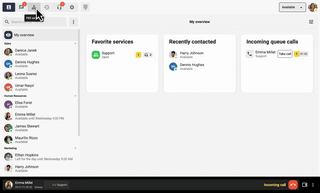Those of you with offices in several countries know that it can often be a challenge to communicate across borders. With separate telephone operators and exchange systems, it’s almost impossible to keep track of who’s working on what across the ocean. With a unified telephony solution that brings all your communication needs together in one platform, you can avoid the hassle of dozens of different invoices, contact persons and support numbers.
Introduction
In this guide, we’ll tell you how you can reduce your expensive telephony costs and increase internal efficiency by implementing a common platform for your entire company – whether you’re based in London, Gothenburg or Turku. And you’ll get a whole bunch of happier customers in the process!

Working together across borders – a historic challenge
Companies located in several Nordic countries have historically worked in separate silos when it comes to communication – both internally and with their customers. The only thing they have had in common is the domain and the same email management. Otherwise, communication has been completely separate in each country, with unique operators and telephone exchanges for each market.
Employees in these companies, who have rarely had anything more than an email address and a phone number for colleagues on the other side of the border, have had to put up with the situation. Direct contact is difficult when you don’t know if a colleague is at lunch, in a meeting or out for the day – and the time differences don’t make it any easier! Distancing has been a fact of life when you have no overview of who has the same role as you in Denmark or Finland, especially when you only meet for a kick-off once a year.
With multiple suppliers in each country where the company operates, there have also been an extreme number of elements to keep track of in terms of responsibilities, procedures and costs. Not only does the IT manager or client need to keep track of several systems – they also have invoices coming from different sources, different contact persons and several support channels to deal with. It’s hard to get an overview – and it’s a recipe for trouble!
Modern communication platforms are cloud-based
It was a long time ago that it was considered profitable to buy a physical system to be connected and maintained between different countries. The modern way to buy PBX services today is to get a reliable, comprehensive provider that is up to date with the latest features, and knows what Nordic businesses need. With a cloud-based service, you always have access to new developments and technologies, without having to ask for them. Today, all telephony providers strive to constantly offer their customers the very latest – and the very latest is in the cloud!
By integrating telephony and switchboard systems with other tools, such as Microsoft, it is also possible to further streamline your work. With the calendar in sync, it never has to ring again in the middle of an ongoing meeting, and when you have your CRM connected to the switchboard, you can immediately see what current dialogues or previous challenges a customer who calls in has.
Reading tip: Why fintech company Iynett chose to integrate its CRM with the exchange service
Customer satisfaction depends on a unified system
If you don’t have a good digital platform across the Nordic region, you risk not only failing in your internal communication, but it can also affect overall customer satisfaction. By getting an end-to-end solution, it’s just as easy to get help from a colleague in Bergen as it would be if they were sitting next door to you in your Stockholm office. For a customer who calls in to the company’s switchboard, the forwarding is very much a factor that reveals whether you really have an eye on each other in the company – or whether you are acting in your own silos. A common system means that everyone has access to information about customers – regardless of who they have spoken to before or in which channel.
Creating synergies between countries
When offices are on the same footing, there is also a great opportunity to benchmark efficiency, country by country or department by department. It’s easier to measure results and needs on the same premises in a common platform – a great advantage for staffing correctly across offices, for example.
Reading tip: Siedle Nordic: “We now have a single switchboard service for all Nordic countries”
Telephony and switchboard linking the offices
Video calls, emails and text messages are all well and good, but what has always been most important for effective, clear and direct communication is the phone call! With a common platform where the telephone and switchboard are a fundamental part of your business, it will be easy to develop your communication in several directions – both internally and with customers.
Many in the younger generation prefer to chat with businesses as a first step in communication. It’s easy to send a Facebook message to ask about an invoice, and easier to chat with support if you have trouble logging in somewhere. The smaller the issue, the faster you expect to get help. Communication is on the customer’s terms, and it is important not to dismiss social media, chatbots or self-service portals just because the company is not comfortable with these communication channels. A shared digital cloud platform for communication offers great opportunities to start using new channels – without having to develop anything on your own.
A common AD for a complete overview
In a comprehensive AD (Active Directory), you can easily collect data on all your company’s workforce – across all countries of operation. Here you enter all employees’ skills, department, title, immediate manager, cost center and responsibilities – a complete list, simply put. With a well-functioning AD, you get a master for all your company’s employees, which also syncs with other necessary systems and tools in your company.
An AD is usually hosted in the Microsoft environment, which makes it easy for external suppliers to connect to it. Both the phone and payroll systems get all their information from here, and your employees will never have to go to multiple places to update their data.
Facilitating linguistic differences
Cultural differences are also much easier to bridge when you can access each other directly on your mobile phone. Local titles, for example, can be very difficult to translate – which can mean that tasks and responsibilities become unclear. In the worst case scenario, you in Sweden have no idea what myymäläpäällikkö* means, which means that your colleague on the other side of the Åland Islands might get the wrong call connected to them.
With a common solution, this is a simple problem to solve. Each person is assigned different titles in the system depending on their chosen language, and it’s easy to search across competencies. Next time it’s time to connect a call or collaborate on a task, it’s easy to find the right person on the first try!
*store manager
Save big costs with the same system
Moving to a common telephony and switchboard system for all your offices brings major cost benefits for the whole company. Here are four key elements:
1. one supplier instead of 15
If you have previously had separate telephony systems in each country, it is not unusual for this to have required different operators as well as mobile and fixed network providers. By acquiring a common communication platform via one and the same supplier, you can save a whole lot of administration around invoices, dialog and support – and thus also big money.
2. Flat rate subscriptions for all countries.
In Sweden, it has long been common practice to charge the same rate regardless of which telephone number you call within the country. However, calling a colleague in Denmark or Norway has been treated as an international call – even though you belong to the same company. With a single switchboard, you get all your numbers under one contract and avoid extra charges for cross-border calls.
3. free calls throughout the Nordic region
In addition to allowing you and your colleagues to call each other for free, a shared PBX also gives you free calls to the whole of the Nordic region, including outside your company, when you call landline numbers or mobile subscriptions.
4. Continuous upgrades of the switchboard
With a cloud service, you don’t have to keep up to date with the latest news yourself, and you don’t have to pay to get new features in place. Instead, this is included in the contract and your provider ensures that you always have the latest.
In summary: 5 benefits of a common communication platform
Overview for administrators. When all employees are connected in the same system, you only need to enter and update data in one place.
A single contract for the entire Nordic region. A single supplier for both telephony and switchboard means that you get both a single invoice and a single contact route.
Check on colleagues in real time. On your mobile or desktop, you can see exactly when your colleagues are available, both locally and in other countries.
Synchronized tools. By linking CRM and other business systems to the phone system, you bring not only communication, but also work, together in one place.
Happier customers across the Nordics. Every issue is resolved more efficiently when you keep track of each other internally, which means customers get help faster.

